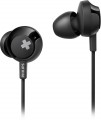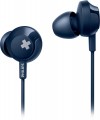The location of the
microphone, which the headphones are equipped with (if available, of course).
— On the cable. A microphone installed on the headphone connection wire (or on the connection cable in non-TWS wireless headphones). Can be combined with
volume control. This option allows you to separate the microphone and headphones, reducing the weight and dimensions of the "ears" themselves; on the other hand, the microphone when worn is often quite far from the face, which can be inconvenient. Therefore, this design is mainly used among earbuds and in-ear
headphones, where the size of the "ears" is critical.
— Built into the body. A microphone located in the housing of one of the headphones. This arrangement is convenient because there are no extra protruding parts outside (as in
headphones without a microphone), while the microphone is close to the face, and in some models it is also able to perceive sound according to the principle of bone conduction. However installation in close proximity to the speaker gives additional interference and may degrade the quality of voice transmission. However, these shortcomings are not critical: interference can be compensated, and the built-in headphone microphones, in fact, do not need perfect sound transmission accuracy. Therefore, this option is quite popular nowadays, and it is fo
...und not only in miniature models, for which the absence of unnecessary details on the outside is important, but also in rather large overhead "ears".
— On the bow. A microphone mounted on a small boom that is attached to one of the headphones. The microphone on the bow is the most popular among overhead headphones: a large cup can be supplemented with a boom without sacrificing convenience, and the microphone itself is located far from the headphones, which has a positive effect on the purity of the sound. The boom often has a swivel or detachable mount, which allows you to remove the microphone from the face until it is needed (by lifting the boom vertically along the headband).
— Retractable on the bow. Headband microphone (see above) with a retractable design: the headband can be pulled out of the cup when needed and can be tucked back inside when not in use. These headphones are more compact and have a neater appearance than models with a headband on a swivel mount: in a hidden position, the microphone takes up almost no space outside. The retractable microphone design is especially popular in gaming models (see “Intended Use”): in single-player games where you do not need to communicate with comrades, the microphone can be folded compactly.
— Removable on the shackle. Headband microphone (see above), which can be completely detached from the headphones if desired. Such a design can be useful, for example, if the “ears” are used both as gaming and as “marching and musical”: in a multiplayer game, the microphone is indispensable, and for listening to music outside the home, it can be removed so as not to carry extra equipment (which besides, you can lose).
— At the receiver. A variant used in wireless headphones with a separate receiver. In terms of design and use, it is similar to the microphone on the cable described above: on the one hand, the headphones themselves can be very light and tiny, on the other hand, the microphone may not be located close enough to the face, and when talking it will have to be brought closer.
— In the mount. In this case, most often means a microphone mounted on a neck mount (see below). This option is found mainly among wireless headphones, which have a signal receiver in the same mount. Such a microphone is located close to the neck, which allows you to achieve good speech intelligibility and at the same time cut off extraneous sounds even without any special additional tricks.
— On the cable and in the case. Headphones equipped with two microphones — one in the case, the other on the cable. The features of these variants are described in detail above. Here we note that their combination is extremely rare, mainly among high-quality "ears" with a combined connection (see "Type of connection"). In such models, when working via a wireless channel, a microphone in the case is used, and when connecting a wire, a microphone on a cable is used, which is less susceptible to interference.
— On cable and removable. Another kind of headphones with two microphones, also quite rare. One microphone in such models is mounted on a cable, the second — on a detachable bow. See above for more on each of these options, and combining them allows you to tailor the headphones to the specific situation. For example, the bow is very convenient for voice communication at home or office computers, but on the street and in transport it is better to remove it and use the microphone on the cable.
— In the case and removable. A rather rare and non-standard option is the combination of a microphone in the case and a microphone on a detachable bow. See above for more details on each of these varieties, and their combination is used quite rarely — in separate premium gaming models with a combined connection. The main point in this case is that it is more convenient to use a removable microphone in one place, with a wired connection, and in the “mobile” wireless mode it is better to remove it and get by with the built-in microphone. However, such features are fundamental mainly for the most demanding users, so this option has not gained distribution.The total weight of the headphones; for true wireless models (see "Cable Type"), the weight of each individual earbud is listed.
This parameter is directly related to the design (see above) and some features of the functionality. Thus, the mentioned true wireless devices are very light, their weight
does not exceed 25 g. More traditional in-ears and in-ears can be noticeably heavier,
up to 50g for in-ears and up
to 100g for most in-ears. Overhead models, for the most part, are quite massive: among them there are many models weighing
200 – 250 g,
250 – 300 g and even
more than 300 g. It should be noted that a significant weight for false ears is often not a disadvantage, but an advantage: it allows them to stay on the head more securely, creates an impression of solidity and reliability, and most often does not create significant inconvenience.

